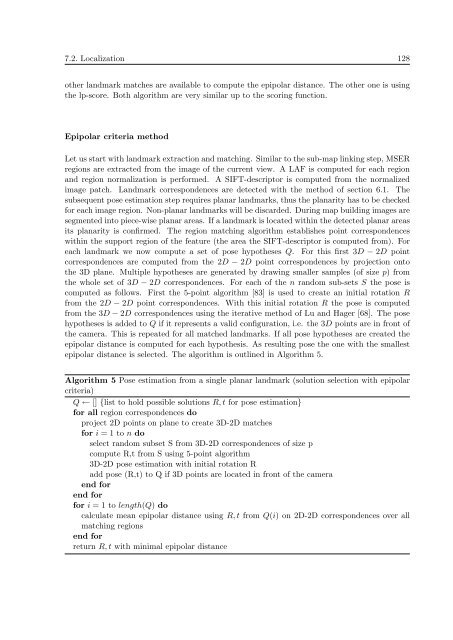PHD Thesis - Institute for Computer Graphics and Vision - Graz ...
PHD Thesis - Institute for Computer Graphics and Vision - Graz ...
PHD Thesis - Institute for Computer Graphics and Vision - Graz ...
You also want an ePaper? Increase the reach of your titles
YUMPU automatically turns print PDFs into web optimized ePapers that Google loves.
7.2. Localization 128<br />
other l<strong>and</strong>mark matches are available to compute the epipolar distance. The other one is using<br />
the lp-score. Both algorithm are very similar up to the scoring function.<br />
Epipolar criteria method<br />
Let us start with l<strong>and</strong>mark extraction <strong>and</strong> matching. Similar to the sub-map linking step, MSER<br />
regions are extracted from the image of the current view. A LAF is computed <strong>for</strong> each region<br />
<strong>and</strong> region normalization is per<strong>for</strong>med. A SIFT-descriptor is computed from the normalized<br />
image patch. L<strong>and</strong>mark correspondences are detected with the method of section 6.1. The<br />
subsequent pose estimation step requires planar l<strong>and</strong>marks, thus the planarity has to be checked<br />
<strong>for</strong> each image region. Non-planar l<strong>and</strong>marks will be discarded. During map building images are<br />
segmented into piece-wise planar areas. If a l<strong>and</strong>mark is located within the detected planar areas<br />
its planarity is confirmed. The region matching algorithm establishes point correspondences<br />
within the support region of the feature (the area the SIFT-descriptor is computed from). For<br />
each l<strong>and</strong>mark we now compute a set of pose hypotheses Q. For this first 3D − 2D point<br />
correspondences are computed from the 2D − 2D point correspondences by projection onto<br />
the 3D plane. Multiple hypotheses are generated by drawing smaller samples (of size p) from<br />
the whole set of 3D − 2D correspondences. For each of the n r<strong>and</strong>om sub-sets S the pose is<br />
computed as follows. First the 5-point algorithm [83] is used to create an initial rotation R<br />
from the 2D − 2D point correspondences. With this initial rotation R the pose is computed<br />
from the 3D − 2D correspondences using the iterative method of Lu <strong>and</strong> Hager [68]. The pose<br />
hypotheses is added to Q if it represents a valid configuration, i.e. the 3D points are in front of<br />
the camera. This is repeated <strong>for</strong> all matched l<strong>and</strong>marks. If all pose hypotheses are created the<br />
epipolar distance is computed <strong>for</strong> each hypothesis. As resulting pose the one with the smallest<br />
epipolar distance is selected. The algorithm is outlined in Algorithm 5.<br />
Algorithm 5 Pose estimation from a single planar l<strong>and</strong>mark (solution selection with epipolar<br />
criteria)<br />
Q ← [] {list to hold possible solutions R, t <strong>for</strong> pose estimation}<br />
<strong>for</strong> all region correspondences do<br />
project 2D points on plane to create 3D-2D matches<br />
<strong>for</strong> i = 1 to n do<br />
select r<strong>and</strong>om subset S from 3D-2D correspondences of size p<br />
compute R,t from S using 5-point algorithm<br />
3D-2D pose estimation with initial rotation R<br />
add pose (R,t) to Q if 3D points are located in front of the camera<br />
end <strong>for</strong><br />
end <strong>for</strong><br />
<strong>for</strong> i = 1 to length(Q) do<br />
calculate mean epipolar distance using R, t from Q(i) on 2D-2D correspondences over all<br />
matching regions<br />
end <strong>for</strong><br />
return R, t with minimal epipolar distance















